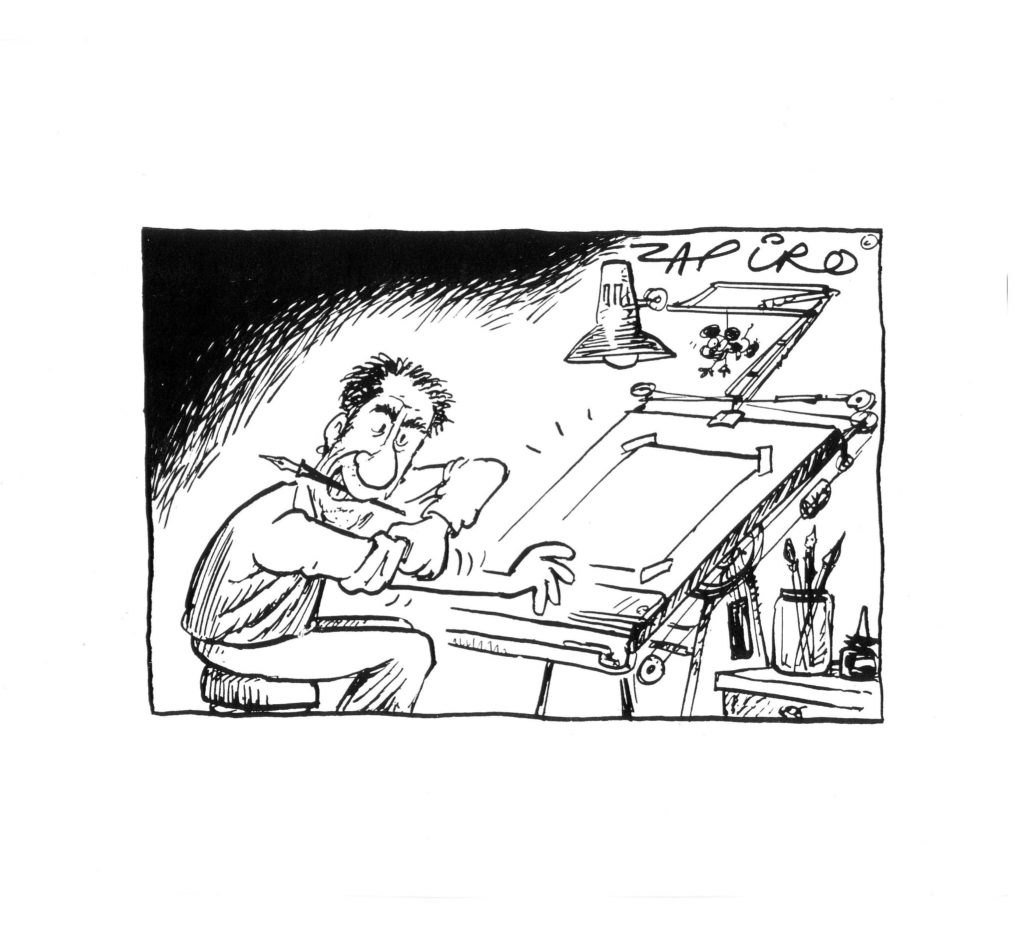He is the political cartoonist who was sued by his president and won. He has made a name for himself by being outspoken and critical and he’s not about to slow down.
Jonathan Shapiro has been publishing his annual collections of drawings in the Mail & Guardian and Sunday Times newspapers for 19 years. In 2014, his book, It’s Code Red, features left-wing, overall-clad opposition party leader, Julius Malema, marching into South Africa’s Parliament on its cover. Inside, it’s a record of 12 months in a country weighed down by political scandals and high-profile murder trials. On page 87, however, is a ray of sunshine: an illustration depicting a conversation between two children – one white and the other black – discussing how far South Africa has come since the first democratic election 20 years ago. It’s playful and a bit silly and it sums up the man who draws South Africa’s news for a living.
“There is a difference between scepticism and cynicism. I am a sceptic and that means someone who reads between the lines and doesn’t take things at face value. The cynic doesn’t believe that anything’s good. I am not cynical about South Africa. I’m a patriotic sceptic,” says Shapiro.
“The whole idea of being a critical cartoonist is that my drawings will start a debate and hopefully something good can come out of that.”
Shapiro, known to those who read him as Zapiro, grew up in Cape Town and worshipped at the altars of Tintin creator Georges Remi and Charles Schultz of Peanuts fame. Pursuing cartooning as a career however was not on the cards and a teenage Shapiro enrolled in a seven-year architecture degree at the University of Cape Town (UCT).
Loading...
“I lost confidence in my abilities and I didn’t think I could make a career out of being a cartoonist. I was lacking the vision to pursue my dreams.”
Shapiro’s university career in the late 1970s and early 1980s overlapped some of South Africa’s darkest years under the apartheid regime. His political views were progressive but Shapiro struggled to fit in with the student anti-apartheid movements which were simmering – and occasionally boiling over – at the university. Things changed in 1983 when Shapiro’s mother, Gabby, became involved in the political party the United Democratic Front and recruited most of her family to the cause within months.
Shapiro’s political awakening coincided with more time spent cartooning.
“The first time I did a political caricature was in my second year at varsity. The subject was the head of the architecture department at UCT. The picture showed the duplicity of his personality and the way he ran the department. He flew off the handle and that was when I first realized that my cartoons – these pictures that I drew – had a potential to be powerful. Definitely more powerful than anything my architecture work could accomplish,” he says.
Shapiro changed majors from architecture to graphic design after a month of backpacking through Europe as a fourth year student visiting, mostly unannounced and uninvited, the art studios where some of the world’s best loved comics such as Asterix were drawn.
“It was a shot in the arm. I came back to South Africa and told my parents I wanted to change my degree to graphic design. They were unbelievably supportive.”
Shapiro’s first fulltime cartooning job was at the now defunct South newspaper in 1987. He has spent almost three decades since then depicting the fall of apartheid, the country’s transition to democracy and the travails of the various presidential administrations.
“What gets me really down is when things get really bad politically and trying to find the glimmers of hope is not easy,” he says.
His cartoon depicting the rape of Lady Justice – a metaphor featured repeatedly in his work – by President Jacob Zuma was met with outrage by the ruling party and many members of the public. Shapiro’s only concern around the picture’s publication was that it may be interpreted as insensitive to women.
“Critical cartooning is the foray into the taboo as well as the pushing and the prodding which breaks down boundaries and creates discourse in society.”
Shapiro’s work is increasingly critical of Zuma – who has been immortalized into South African consciousness as ‘shower head’ on account of Zapiro’s work.
“I am not anti-ANC but I am against the corruption and the complacency prevalent in the ruling party. It is actually unbelievable to do cartoons in this environment because you become part of the moment, part of that political discussion.”
Shapiro works from a home studio in Cape Town. He has no plans to give up cartooning and doesn’t anticipate running out of material in the foreseeable future.
“Sometimes reality in South Africa is weirder that anything I could ever dream up.”
Loading...
